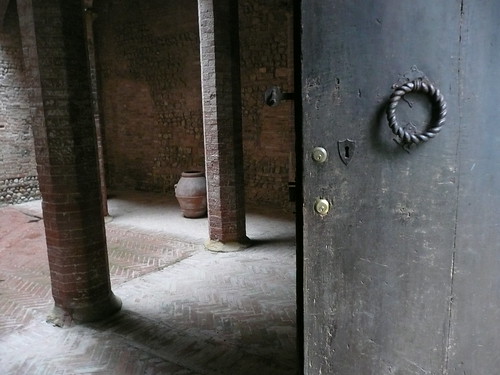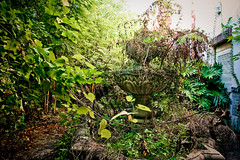
This review is superior, in its conception at least, to your typical RPG review in two ways. First, I review the product based on my experiences using it in play, rather than after merely reading it. Second, because my experiences with the product were as a player, I can, and will review the product, based on the perspectives of a player. Because I hope players out-number refereees in most sessions, this makes my review more directly relevant to more people. Obviously, the experienced referee and the professional game designer have their own strengths that they bring to the reviews that they write, but I won’t try to compete with those, at least in this post. A friend of mine got an advance proof of L&M at least a month ago and I’ve played in 3 or 4 of the sessions he runs weekly. As he’s run it, L&M feels like what Gary Gygax seemed to have envisioned for the Keep on the Borderlands, but that I never quite pulled off when I tried running that classic module: a multi-layered, multi-leveled adventuring locale paired with a base town that offers not only a relatively safe place to rest your head, but also some intrigue of its own. Granted, my friend is better at running a game than I was at 10 or 12 or 16, but just glancing through the four books that comprise L&M, I sense that he’s been given a few more tools to work with than the bartender’s preference for honey mead over small beer. The greater accomplishment by The Monkeys is in Lesserton, the dirty little town serving as the PCs “base.” I’m not so much saying that Lesserton is “better” than Mor, the sprawling ruins of a once powerful city, but that I don’t know that I’ve ever seen a town/base with such personality, and with the right balance of fixed and dynamic elements. Today’s technology allows The Monkeys to provide players with a free pdf Player’s Guide to Lesserton, and I think this greatly enhances play. It provides a very high-level account of the history of the town, and then moves into concise, but flavorful descriptions of the various neighborhoods, focusing on surface-impressions rather than facts. In other words, it gives players the sense that their characters have spent a little while looking around than the town, and NOT that they’ve just read about something on Wikipedia. The 5 neighborhoods are described both in terms of an overall theme (rich, poor, middle-class, commercial vs. residential) and with two sentence descriptions of notable buildings. I didn’t read the whole thing before I playing. I haven’t read the whole thing yet. But it gives us all a common reference throughout play. We all know what it means when someone says, “I’m going to buy some clothes so I won’t look so conspicuous walking around The Heights.” As it turns out, that character had to settle for buying clothes so he wouldn’t look so offensively poor as to deserve a sound drubbing. And if I can point to one place where the texture and flavor of Lesserton comes from, it’s in the player’s guide section about creating a new character in Lesserton, the most important detail being that PCs start with gold equal to their Charisma with which to buy equipment. Not charisma times 10, but just Charisma. In the case of a charming young magic-user, 15gp is pretty awesome, but it goes quickly, and a little bout with addiction can reduce you quickly to rags, 10 feet of rope, and two rocks. Most everyone you meet in Lesserton is similarly poor and desperate if not more so. Finding a ring in your sausage is a reason to go back to the place you got it—and plunk down another handful of coppers to buy another, hoping for more good luck. Pooling resources to buy a small barrel of lamp oil or “fire-starter” to trade to the Orkin tribes of Mor for cruelly-addictive wild honey to resell to folk of Lesserton is a respected (if illegal) business plan. Over-friendly barmaids with their hands all over you really are very frightening, because they can snatch the few coins that would save you from starving this week. This is not to say Lesserton is joyless or lawless. You can have a lot of fun playing toss-bottle or racing centipedes (maybe not for my PC). There is a town watch. And there’s a temple of divine purpose. So you can’t rough-up the barmaid to get your ring back. The priests really do want addicts to get better. And although you can’t report that elf who stole your spell book to the authorities and expect them to do anything about, you need to get him out of town before you can take justice into your own hands . . . along with the elf's boots and the fancy bridle on his horse . . . and his empty scroll case . . . and To be honest (go on junkie, be honest), not all of Lesserton’s diversions translated well to the game mechanics of D&D, at least not for me. For instance, the idea of different colored centipedes racing each other to get to a staked giant insect is some kind of highly original cool. But resolving it with d20 roll was a little anti-climactic. Then again maybe that’s because my character didn’t have any silvers to bet. For whatever reason, the other players seemed to enjoy this—and toss-bottle more than I did. But to get back on my wave of enthusiasm, Lesserton is a great place for a different kind adventure because despite the corruption and desperation, it’s not a dungeon and you live by your wits, not your sword or your spells. As someone who has real-life experience living somewhere that boys compete with goats to dig breakfast out of other people’s garbage pile, and where too-successful business attract on-the-spot tax assessments, it feels real and alive, donkey-eared, walrus-toothed Orkin bodyguards notwithstanding.












